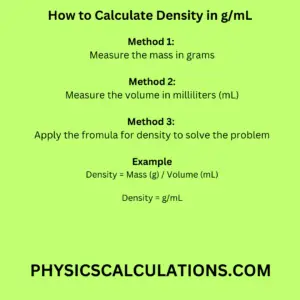How to Calculate Density in g/mL
To calculate density in grams per millilitre (g/mL), measure the mass (in grams) of the substance and its volume (in millilitres). Then, use the formula:
Density (ρ) = Mass (m) / Volume (V).
Divide the mass by the volume, ensuring consistent units, to obtain density in g/mL.
Density (ρ) = Mass (g) / Volume (mL).
Explanation (Density)
Density is the mass per unit volume of a substance. It measures how tightly packed the particles are within a given volume. The formula for calculating density is straightforward:
Density = Mass / Volume
The resulting value is in units such as grams per millilitre (g/mL), grams per cubic centimetre (g/cm³), or kilograms per litre (kg/L). In this article, we will focus on the g/mL unit.
How to Calculate Density in g/mL

To calculate density in grams per millilitre, you need to determine the mass and volume of the substance you’re working with. Here’s a step-by-step guide to help you through the process:
Step 1: Measure the Mass
Using an accurate scale, measure the mass of the substance in grams. Ensure that your scale is properly calibrated for precise measurements.
Step 2: Measure the Volume
The volume can be determined differently depending on the nature of the substance:
- For regular-shaped objects: Measure the length, width, and height using a ruler and calculate the volume using the appropriate formula (e.g., V = l × w × h for a rectangular object).
- For irregular-shaped objects: Use displacement methods such as the water displacement method. Fill a graduated cylinder with a known volume of water, carefully submerge the object, and measure the change in volume. The difference will give you the volume of the object.
Step 3: Calculate the Density
Divide the mass (in grams) by the volume (in millilitres) to obtain the density in g/mL. Make sure your units are consistent throughout the calculation.
Density (g/mL) = Mass (g) / Volume (mL)
Therefore, Density = g/mL
Practical Applications of Density
Understanding density and being able to calculate it in g/mL is valuable in various real-world scenarios. Here are a few examples:
1. Quality Control in Manufacturing
Density measurements help ensure the consistency and quality of manufactured products. By calculating the density of materials used in production, manufacturers can identify any variations or defects that may affect the overall performance or characteristics of the final product.
2. Identification of Substances
Density is often used as a characteristic property to identify unknown substances. By comparing the calculated density of an unknown sample with known densities of different materials, scientists and analysts can determine the composition of the substance.
3. Determination of Purity
We use density measurements to determine the purity of substances. Impurities can alter the density of a material, so by calculating its density, analysts can assess the level of purity and identify any contaminants present.
4. Buoyancy and Flotation
Density plays a crucial role in understanding the buoyancy of objects in fluids. By comparing the density of an object
to that of the fluid it is immersed in, we can determine whether the object will sink or float. This principle is essential in various applications, such as shipbuilding and designing flotation devices.
Conclusion
Density is a vital concept that helps us understand the relationship between mass and volume. By mastering the calculation of density in g/mL, you gain the ability to analyze and interpret the physical properties of substances accurately.
Whether you are involved in scientific research, manufacturing, or simply curious about the world around you, understanding density opens up a world of possibilities. So go ahead, apply the knowledge you’ve gained, and explore the fascinating realm of density in your scientific endeavours.
Remember, practice makes perfect, so keep honing your skills in calculating density, and embrace the endless possibilities it offers!
You may also like to read:
How to Calculate Density of Water